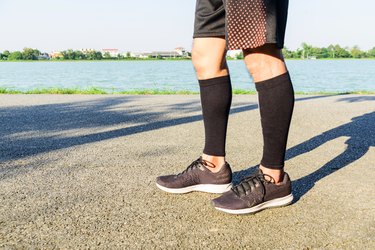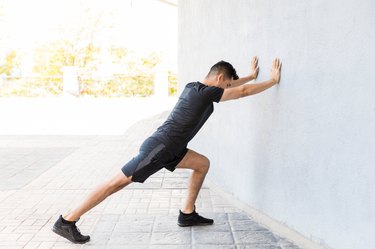
Sure, calf size is partly set by genetics, but there are plenty of things you can do if your goal is to get bigger calves at home. Your calves are an important muscle group that include the gastrocnemius and the soleus, which, together, are responsible for plantar flexion (pointing your toes downward).
While many people want bigger calves for vanity reasons (who doesn't like looking at a set of chiseled calves?), it turns out that they may be an indicator of heart health. A November 2008 study published in the journal Stroke found that regardless of age, gender, body mass index and other risk factors, the bigger people's calves were, the fewer fatty deposits (plaques) they built up in their arteries.
Video of the Day
To build bigger, more-defined calves through exercise, experts recommend the following exercises as your best bets. You'll need access to a staircase or step, a chair and a set of dumbbells or two gallon jugs filled with water.
Try Calf Raise Variations for Stronger Calves
"My go-to at-home calf-building exercises are double and single calf raises," Michelle Miller, CEO of MM Fitness in Tallahasse, Florida, and founder of My First Workout, tells LIVESTRONG.com.
But it's important to not rush through the range of motion. "To help my client remember to control the eccentric (downward) phase, I have them imagine my finger is under their heel, and I say that it's ok to touch my finger but not to squish it. That little trick keeps the muscle working longer."
Try incorporating one of these calf raise variations into your next lower-body workout.
Standing Calf Raise
- Place your toes on the bottom step of a staircase or a sturdy step-stool. If you don't have steps in your house, you can do them on the ground as long as you don't touch the floor in between reps.
- Hold dumbbells or water jugs in your hands to increase the resistance.
- Position your feet shoulder-width apart with your heels hanging over the edge.
- Lift up onto the tips of your toes and hold for a full second.
- Lower your heels down slowly until your feet are in an upward angle. Hold this position for a full second and repeat.
- Repeat 20 to 30 times for one set (or about 10 to 15 reps if you're adding weights). Rest for 10 to 20 seconds, then repeat for 3 to 4 sets.
Tip
"I normally start with toes pointing forward for one set and then out to the corners for a set and finish with toes pointing in," Miller says. "This exercise targets all three heads of the calves really nicely. "
You can also do this move sitting down to isolate your soleus, she says, which gets activated most when your knees are bent.
Single-Leg Dumbbell Calf Raise
- Position the toes of your right foot on the bottom step of a staircase, a sturdy step-stool or on the ground.
- Let your heels hang over the edge. Wrap your left foot around your right calf.
- Lift up onto the tips of your right toes and hold for a full second.
- Lower your heels down slowly until your feet are in an upward angle. Hold this position for a full second and repeat.
- Hold dumbbells or water jugs in your hands to increase the resistance.
- Repeat for 10 to 15 reps, then switch sides. Do 3 to 4 sets on each side.
Tip
Single-leg raises really increase the challenge from the double-leg version. "For the single-leg raise, I have my client hold onto a wall and wrap the foot of the non-working leg around the lower calf of the working leg," says Miller.
"In addition to elevating the foot, place a moderate to heavy dumbbell in one hand and the calves will have to work even harder."
Take It Outside
While the above workout moves will help isolate the calf muscles, don't underestimate the benefit of stepping outside for an uphill walk or run. Running is a vigorous form of cardio that activates your glutes, quadriceps, hamstrings — and yes, your calves — to propel you forward. Fast-paced walking, especially up-hill, can have a similar effect.
To try it, find a nearby hill that's approximately 100 yards long. Jog or walk for five minutes on flat ground to warm up, then come to the bottom of the hill. Run to the top, jog back down, then run back to the top. Repeat 8 to 12 times. Run at a slower pace up the hill to really engage your calf muscles. Alternatively, you can walk up and down the hill.
Don't Forget to Stretch
Proper stretching of the calves will help you avoid injury and help your muscle recover. After each calf workout or uphill run/walk, perform calf stretches on both legs to elongate the muscle and help repair small tears in the muscle fibers.
Calf Stretch

- Stand near a wall with one foot in front of the other, front knee slightly bent.
- Step the other foot back, keeping the knee straight and your heel pressed into the ground.
- Lean toward the wall. Feel the stretch all along the calf of your back leg, holding the stretch for 20 to 30 seconds.
- Switch legs and repeat.
Was this article helpful?
150 Characters Max
0/150
Thank you for sharing!
Thank you for your feedback!